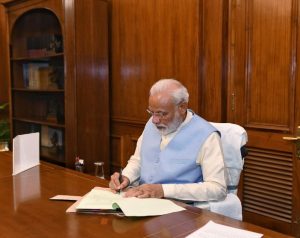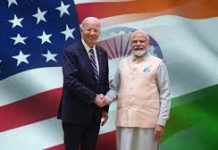 Having swept into second term with a thumping majority, the Modi 2.0 government has unleashed its 100 day agenda wherein it is likely to fine-tune the personal income tax in the budget, spur private consumption, double farm income by 2022, expand and simplify GST, bank recapitalisation and consolidation, national retail policy, infra push, hike in defence budget. The construction of Ram Mandir and abrogation of article 370, procurement of Rafael will have to wait !.
Having swept into second term with a thumping majority, the Modi 2.0 government has unleashed its 100 day agenda wherein it is likely to fine-tune the personal income tax in the budget, spur private consumption, double farm income by 2022, expand and simplify GST, bank recapitalisation and consolidation, national retail policy, infra push, hike in defence budget. The construction of Ram Mandir and abrogation of article 370, procurement of Rafael will have to wait !.
Modi pegs 100-day agenda in IT, infra, GST, defence !
Aiming at a US $ 5 trillion economy in its manifesto the construction of Ram Mandir and abrogation of article 370, procurement of Rafael will have to wait for the later period .. even though the economic growth is likely to slide to below 7 per cent .!. A report by Sanjay Thapa Jeet
As announced in its 2019 manifesto, the BJP has aimed the Indian economy to touch US $ 5 trillion economy by 2025 This comes at a time when the economy is expected to dwindled down to 6.1 per cent to 5.9 per cent in the last quarter of the FY 2018-19 thus bringing down the full financial years projection to below 7 per cent from earlier 7.2 per cent. On the personal income tax front the Modi government had setup a task force in 2017 to reform the 50 year old income tax act legislation. In this direction the Modi 2.0 government likely to formalise a legislation which it passed in the interim budget as an exemption to enhance the income tax limit to Rs 5 lakh per annum and increase in standard deduction to Rs 50,000 per annum.
On the GST front, the government is likely to move towards easing out the top two layers of 28 per cent and 18 per cent and include ATF in the GST. With this the large number of goods and services are likley to be subsumed in the 5 per cent and 12 per cent category. The move to push fuels under the GST would take a longer consideration of the GST Council where all the stake holding states would have to agree to a common consensus and thus may take a longer time period. Apart from this, there is also on agenda to enhance insurance cover to migrant workers as well as extend cover to 100 million workers under the ESIS. Jan Aushadi kendras are likely to get a fillip in the100 days agenda with more pathology labs and medicines becominng more affordable in the next 100 days of the Modi 2.0 era.
On the fiscal front however it would be tight rope walk as the targetted fiscal deficit of 3.4 per cent of the GDP for FY 2019 and FY 2020. On the hand given the drop in the manufacturing sector to a 20 month low at 0.1 per cent for February and given the headline inflation rate under the 4 per cent inflation targetting norm there is enough room to spur credit growth. In this direction, there is a strong case for the RBI to soften the interest rates by 0.50 percentage points in the coming monetary policy next month. But there has has to be an assurance that the banks will pass off the interest rate cut and spur credit growth unlike in the past. Save the intitial period, inflation is also likely to face an upward pressure in the coming days with the monsoons playing traunt in the LTE with a precipitation of 95 per cent , with a deviation of 10 per cent either way. This may cause an upward spiral in the food inflation around the middel of June after the monsoons takeon by the first week of June as is being expected.
A national retial policy is being pushed by the DPITT under the Commerce Ministry. The department has readied a plan to push e-commerce and domestic trade. The policy which was under the Consumer Affairs Ministry has been shited to DPITT recently. The policy is expected to push domestic trade amongst 650 million traders .All stake holders including state government and traders are likely to help boost the export growth apart from enhancing domestic trade.
Another sector that is likely to face major upheavel is the education sector. The Modi 2.0 government is planning a new national education policy to include 10 odd Institutes of Eminence to the present number of 20. The HRD Ministry is ready to unveil its new five year vision document policy which include technology upgradation, research and innovation, employebility, excellence, quality, accreditation, international acceptance and funding. In the area of software excellence, PM Modi had chaired a cabinet meeting wherein it has passed a National Software Export Policy wherein the policy dictates the hike in software exports from India ten folds by the year 2025.













